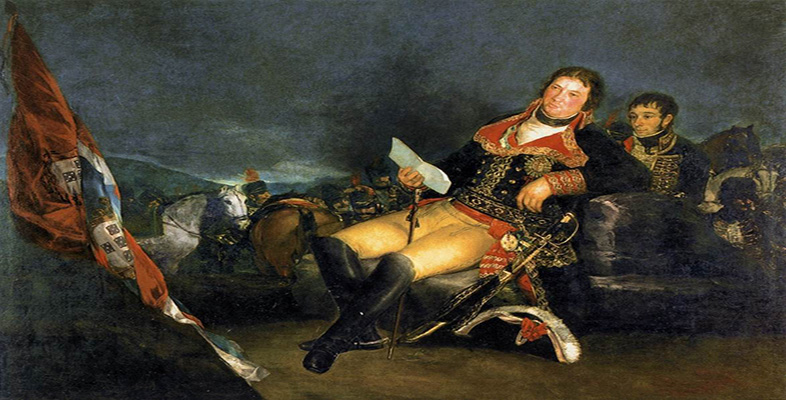1.2 Napoleon and the Spanish imbroglio
Napoleon later admitted that his intervention in Spain in 1807 was among his worst mistakes. He referred to it as ‘the Spanish wasps’ nest’ or ‘the Spanish ulcer’, which divided and exhausted his military strength. While Napoleon probably intended to annex the Iberian peninsula to his French empire in any event, his immediate involvement arose from his decision in November 1806 to impose the Continental Blockade or European boycott of British goods, in the hope of defeating Britain by means of an economic stranglehold. (After Nelson's victory at Trafalgar in 1805, Napoleon accepted that he could not defeat Britain at sea.) In 1807 he sent French troops through Portugal with the co-operation of the corrupt Spanish minister, Manuel Godoy (‘the Prince of Peace’), in order to close Lisbon to British trade, enforce the Continental Blockade and break Britain's links with her ‘oldest ally’.
Spain was France's ally against England and Portugal, but much of Spanish opinion in this impoverished and profoundly Catholic country was hostile to the French Revolution and to the Enlightenment as well as to the burdens of the French alliance. (The Spanish as well as the French fleet was destroyed at Trafalgar.) Napoleon was contemptuous of the Spanish royal house of Bourbon (descendants of Louis XIV): the feeble and decadent King Charles (Carlos) IV, his wife Maria Luisa (whose lover was Godoy) and their son Ferdinand (Prince of Asturias), who conspired against his father. Charles got wind of this and placed Ferdinand under arrest in October 1807, but in March 1808 a revolt of Ferdinand's supporters at Aranjuez ousted Charles, Luisa and Godoy from power. Ferdinand acceded as King Ferdinand VII.
Taking advantage of the presence of French troops in the heart of Spain and of these dissensions within the reigning house, Napoleon lured the Spanish royal family to France, ostensibly to mediate between Ferdinand and his parents. At a meeting at Bayonne, however, Napoleon placed them all under house arrest and browbeat both Charles and Ferdinand into renouncing the Spanish throne in favour of Napoleon's elder brother, Joseph Bonaparte. Charles, Ferdinand and Godoy went into exile in France.
Napoleon's insult to Spanish pride provoked a violent popular reaction which spread across the country. Anti-French riots at Madrid on 2 May 1808 (dos de mayo) were suppressed on 3 May (tres de mayo) by Napoleon's brother-in law, Joachim Murat, commander-in-chief of the French army in Spain. Resistance to the French by regular Spanish forces under General Castanos and by irregular guerilla forces sprang up across Spain, and a French army under General Dupont was forced to surrender to Castanos at Bailen in July 1808. This capitulation was a significant blow to France's reputation for invincibility. Meanwhile a British army under Sir Arthur Wellesley landed in Portugal, and forced the French to evacuate that country (August 1808).
Napoleon rushed part of the Grande Armée to Spain, took personal command (November 1808), restored the ousted Joseph to the throne, defeated the Spanish forces and drove the British out of Portugal. Wellesley's successor, Sir John Moore, was killed at La Coruna, but his army was safely evacuated by sea, while Portugal and southern Spain remained unsubdued. Napoleon returned to Paris to deal with the threat from Austria, leaving the Spanish question unresolved.
By January 1809 France's casualties in the Peninsular War exceeded her losses in all of Napoleon's campaigns in Europe hitherto. British forces returned to the peninsula in 1809. 50,000 British troops and their Portuguese and Spanish allies under Wellesley (now Duke of Wellington) ultimately tied down between 200,000 and 300,000 French troops. French depredations, guerilla reprisals and French counter-reprisals made the occupation of Spain a uniquely long drawn out, sanguinary and costly ordeal marked by atrocities on both sides. By 1814 the French forces had suffered in battle and through guerilla attrition losses totalling 240,000 men, as well as huge financial strains. The French were gradually driven out of Spain in the campaigns of 1812–1814, which culminated in Wellington's invasion of southwest France. The ‘Spanish ulcer’ and Peninsular War were a major contribution to Napoleon's defeat.
In 1814 the Bourbon monarchy in Spain was restored to power in the person of Ferdinand VII, who ruled until 1833. During Ferdinand's exile in France an attempt had been made in 1812, by the exiled Spanish parliament, to formulate a liberal constitution for Spain. Ferdinand suppressed such measures in order to reinstate a particularly autocratic form of absolutism. Viewed by many as Spain's saviour from the Antichrist Napoleon, he was quick to purge his country of supporters both of the liberal constitution and of the French regime. In 1814 he reinstated the powers of the Inquisition, previously abolished by Joseph Bonaparte. Although the Inquisition's use of torture and the death penalty had declined in the eighteenth century and its main focus had become issues of censorship, it retained in the minds of liberals the kind of cruel and repressive associations present in popular images, including those of Goya. To supporters of the Bourbon restoration, however, the Inquisition functioned as a symbol of Spain's attempt to cleanse itself of foreign, libertine and Francophile influence.


